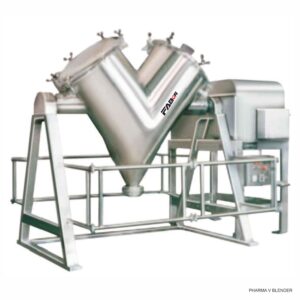Deduster for Granules & FBD Exhaust System
The deduster for granules and Fluid Bed Dryer (FBD) exhaust is used to eliminate fine dust particles from granulated material prior to additional processing, i.e., tablet compression or capsule filling. It also keeps the exhaust air from the FBD free from particulate contamination.
- Deduster for Granules
Granules are prepared in the wet or dry granulation process and must be free of dust before they can be compressed into tablets or filled into capsules.
Technical Specifications:
- Construction Material: 316L stainless steel for contacting parts, 304 for non-contacting parts (GMP compliant).
- Dedusting Mechanism: Makes use of vibration, oscillation, or rotary motion to eliminate fine dust. Fitted with perforated mesh screens or air suction systems.
2. Capacity:
- Usually handles 100 kg to 500 kg per hour, based on granule size and material characteristics.
- Filtration System: Utilizes cyclone separators, HEPA filters, or dust collection equipment.
- Air/Vacuum Requirements: Needs vacuum extraction system with suction capability 2.5–4 m³/min.
- Compressed air supply: 0.1–0.5 MPa.
3. Power Supply: Runs on 220V/380V, 50Hz/60Hz.
4. Integration: May be connected to granulators, blenders, and tablet presses for continuous production line.
- Deduster for FBD Exhaust System
Fluid Bed Dryers (FBDs) produce minute dust particles that need to be captured prior to releasing the exhaust air to avoid product loss and environmental contamination.
Technical Specifications:
- Construction Material:
304 or 316L stainless steel, with polished interior finishes for effortless cleaning.
2. Filtration System:
With bag filters, cartridge filters, or HEPA filters for 99.97% effectiveness (≥0.3 microns).
Utilizes pulse-jet filter cleaning system to automatically remove dust.
3. Air Handling Capacity
Designed to accommodate airflow between 1,500–8,000 m³/h, varying with FBD size.
4. Dust Collection System:
Employing cyclone separators, multi-stage filtration, or wet scrubbers.
5. Integration with FBD:
Syncs with the FBD control system to maintain efficient performance.
Pressure differential monitoring to check for filter clogging.
6.Power Supply:
Powered by 380V, 50Hz/60Hz.
7. Compliance:
Complies with GMP, FDA, and environmental safety standards.
Applications of Dedusters for Granules & FBD Exhaust
8. Granule Deduster:
Removes fine dust from granules prior to tablet compression or capsule filling.
Enhances tablet uniformity and weight consistency.
Prevents contamination and enhances flowability of granules.
9. FBD Exhaust Deduster:
Guarantees clean exhaust air by removing fine particles.
Prevents loss of product and ensures safety of the environment.
Reduces maintenance expenses and extends filter life in HVAC systems.






Reviews
There are no reviews yet.